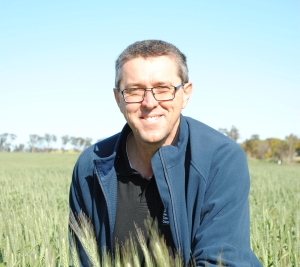Wheat researchers progress quest for better adapted cultivars
Wheat researchers progress quest for better adapted cultivars
Date: 12 Oct 2020

Australian wheat researchers are continuing to break new ground in the quest to develop cultivars with superior establishment potential in a warmer and drier climate.
At the heart of their research is the development of genetic material that offers potential to reduce plant height and increase yields while maintaining longer coleoptile length, greater early vigour and increased weed competitiveness.
The research is an investment partnership between the Grains Research and Development Corporation (GRDC) and CSIRO and aims to deliver germplasm that is well-adapted to future climate conditions.
CSIRO wheat geneticist Greg Rebetzke outlined some of the key areas of the research in a recently released GRDC Updates video.
The work focussed on coleoptile length and aims to widen the potential for deep sowing of up to 140mm to make use of stored soil moisture.
The coleoptile is the protective sheath enclosing the emerging shoot and first leaves, and the longer it is, the greater the emergence potential from deeper in the soil.
Current Australian wheat cultivars contain dwarfing genes that reduce coleoptile length by an average 40 per cent, inhibiting crop emergence when sown at depths greater than 50mm.
In rainfed environments typical of much of the Australian wheatbelt, wheat is commonly dry-sown at shallow depths owing to the risk of poor crop emergence.
A lack of suitable moisture often then delays crop emergence until past the optimal date resulting in yield penalties.
To address this issue, scientists have identified a range of alternative dwarfing genes in overseas wheats that can maintain longer coleoptile length without compromising production potential, developed relevant DNA markers and bred the genes into the old tall wheat variety Halberd and more recently modern wheat varieties for testing and disseminating to Australian wheat breeders.
Deep sowing trials using wheat lines incorporating these genes have been undertaken at the GRDC’s Managed Environment Facilities in Western Australia and New South Wales with promising results, showing increased emergence at sowing depths of up to 120mm without changing plant height.
Dr Rebetzke said Australian wheat breeders now had genes that could produce a wheat plant the same height as Maceor Yitpiwith a longer coleoptile of up to 125mm in length.
“Long coleoptile wheat breeding lines in Yitpi, Mace, Scout, Espada, EGA Gregory and Magenta have been delivered to Australian breeders for testing and use in breeding,” Dr Rebetzke said.
“We are replacing the globally-recognised, green revolution dwarfing genes with new dwarfing genes.
“That’s a big ask given the importance and success of the green revolution genes in increasing grain yield and assuring global food security.
“If there are no problems with the new dwarfing genes, we may see the first of these long coleoptile wheat varieties using these genes in National Variety Trial testing within four to five years.
“The breeders have been very supportive of the work and in efforts to generate new varieties with the long coleoptile trait.”
The ability to establish wheat crops from seed placed 80mm or deeper in the soil would be a significant step forward for many wheat growers, offering planting options in situations where the subsoil is moist following summer rains but the surface is dry.
At the same time, seeding onto moisture at depth may also enable a greater portion of the crop to be sown in the traditional sowing months of May and June, or even earlier in April if rain falls.
However, Dr Rebetzke cautioned that the option of earlier sowing required consideration of the influence of warmer soil temperatures on reductions in coleoptile length.
“Earlier sowing into warmer soils will reduce coleoptile length by as much as 60 per cent so that a variety such as Mace with a 75mm coleoptile at a soil temperature of 15 degrees Celsius will likely have a 40mm coleoptile when the soil temperature is 25 degrees celsius,” he said.
“Together with some seed treatments known to affect coleoptile length, seedling establishment is one of the riskiest periods for growers setting up their crops.”
While the new genetics have been enthusiastically welcomed within the research community, Dr Rebetzke said the in-paddock benefits could be magnified when used with existing seeding technologies and optimal agronomic management.
“Matching new genetics with appropriate agronomy and technologies should ensure the successful emergence and establishment of deep-sown wheats, particularly when sown early to make use of residual soil moisture or to increase sowing opportunities in May and June,” he said.
“There is the opportunity for a system change that will increase profitability and reduce risk in current and future climates with sowing deeper than previously.
“Longer coleoptiles may permit greater flexibility in seed-based fungicide treatments while deeper-sowing could allow for use of knockdown herbicides ahead of crop emergence especially where herbicide resistance to pre-emergent herbicides is an issue.
“There may also be greater flexibility with deep-sowing on typically non-wetting soils where surface moisture is inadequate for germination but there is good summer moisture at depth.”
For more information, download a copy of Dr Rebetzke’s 2020 GRDC Update paper New genetics to improve wheat establishment and weed competitiveness from the GRDC website.
Contact details
For interviews
Dr Greg Rebetzke, CSIRO
0429 994 226
Greg.Rebetzke@csiro.au
Contact
GRDC Adelaide office
(08) 8198 8400
media@grdc.com.au
GRDC Project Code: CSP00182, CSP00199, CSP00200, CSP1307-006RTX,
